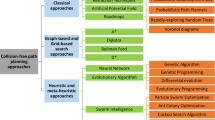Abstract
This paper addresses manipulator redundancy from a global perspective, aiming at kinematic control through the exploration of self-motion topology. The methodology is based on collecting information about the structure of the kinematic map with the use of topological tools, providing an overall view of the configuration space and its relationship to the work space – a suitable framework for the efficient implementation of global approaches. A space discretization method has been developed to benefit from the topological structure, embedding kinematics in its representation. This method enables an efficient exploration of global redundancy resolution and path planning, offering the means to avoid local minima and deadlocks with minimum effort. The discretization was implemented for a planar manipulator, demonstrating significant improvement in the search for globally optimum solutions of path planning when compared to traditional approaches.
Similar content being viewed by others
References
Baillieul, J.: Kinematic programming alternatives for redundant manipulators, in: Proc. IEEE Int. Conf. Robotics Automat., 1985, pp. 722–728.
Bryson, A. and Ho, Y.: Applied Optimal Control, Ginn and Co., 1969.
Burdick, J. W.: On the inverse kinematics of redundant manipulators: characterization of the self-motion manifolds, in: Proc. IEEE Int. Conf. Robotics Automat., 1989, pp. 264–270.
DeMers, D. and Kreutz-Delgado, K.: Canonically parameterized families of inverse kinematic functions for redundant manipulators, in: Proc. IEEE Int. Conf. Robotics Automat., San Diego, 1994, pp. 1881–1886.
Kazerounian, K. and Wang, Z.: Global versus local optimization in redundancy resolution of robotic manipulators, Int. J. Robotic Res. 7(5) (1988), 3–12.
Klein, C. A. and Huang, C. H.: Review of pseudoinverse control for use with kinematically redundant manipulators, IEEE Trans. Systems Man Cybernet. SMC-13(3) (1983), 245–250.
Lück, C. L. and Lee, S.: Self-motion topology for redundant manipulators with joint limits, in: Proc. IEEE Int. Conf. Robotics Automat., Atlanta, 1993, pp. 626–631.
Lück, C. L. and Lee, S.: Redundant manipulator self-motion topology under joint limits with an 8-DOF case study, in: Proc. IEEE/RSJ Int. Conf. Intell. Robots Systems, Yokohama, 1993, pp. 848–855.
Lück, C. L. and Lee, S.: Topology-based analysis for redundant manipulators under kinematic constraints, in: Proc. 34th IEEE Conf. Decision and Control, New Orleans, 1995.
Lumelsky, V.: A comparative study on the path length performance of maze-searching and robot motion planning algorithms, IEEE Trans. Robotics Automat. 7(1) (1991).
Nakamura, Y., Hanafusa, H., and Yoshikawa, T.: Task-priority based redundancy control of robot manipulators, Int. J. Robotics Res. 6(2) (1987), 3–15.
Press, W. et al.: Numerical Recipes in C: The Art of Scientific Computing, Cambridge Univ. Press, 1988.
Rich, E. and Knight, K.: Artificial Intelligence, McGraw-Hill, 1991.
Seraji, H.: Configuration control of redundant manipulators: theory and implementation, IEEE Trans. Robotics Automat. 5(4) (1989), 472–490.
Slotine, J. J. E. and Yoerger, D. R.: A rule-based inverse kinematics algorithm for redundant manipulators, Int. J. Robotics Automat. 2(2) (1987), 86–89.
N. Steenrod, N.: The Topology of Fibre Bundles, Princeton, 1951.
Suh, K. C. and Hollerbach, J. M.: Local versus global torque optimization of redundant manipulators, in: Proc. IEEE Int. Conf. Robotics Automat., 1987, pp. 619–624.
Wampler, C. W.: Inverse kinematic functions for redundant manipulators, in: Proc. IEEE Int. Conf. Robotics Automat., 1987, pp. 610–617.
Wenger, Ph.: A new general formalism for the kinematic analysis of all nonredundant manipulators, in: Proc. IEEE Int. Conf. Robotics Automat., 1992, pp. 442–447.
Whitney, D. E.: Resolved motion rate control of manipulators and human prostheses, IEEE Trans. Man-Machine Syst. MMS-10(2) (1969), 47–53.
Wolovich, W. A. and Elliott, H.: A computational technique for inverse kinematics, in: Proc. IEEE Conf. Decision and Control, 1984, pp. 1359–1363.
Author information
Authors and Affiliations
Rights and permissions
About this article
Cite this article
Lück, C.L. Self-Motion Representation and Global Path Planning Optimization for Redundant Manipulators through Topology-Based Discretization. Journal of Intelligent and Robotic Systems 19, 23–38 (1997). https://doi.org/10.1023/A:1007989214364
Issue Date:
DOI: https://doi.org/10.1023/A:1007989214364




